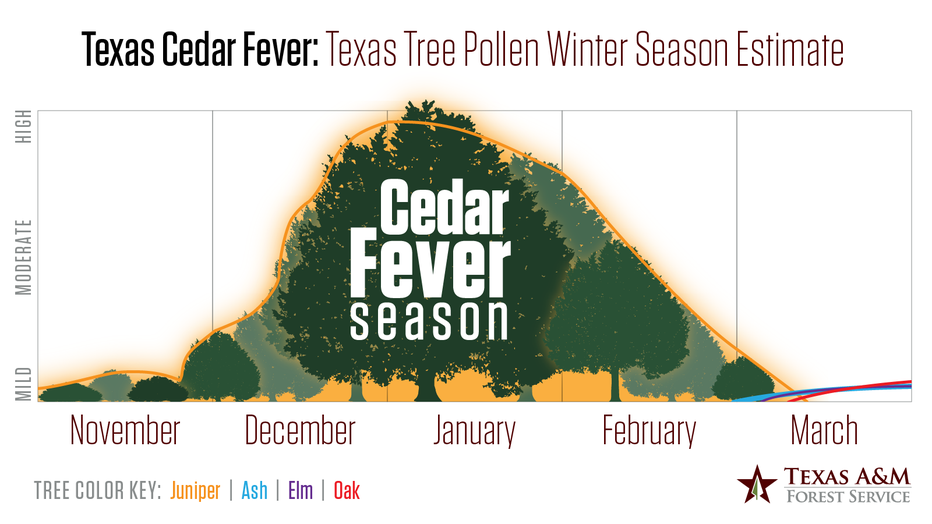Cedar fever season in Texas: What are the symptoms of cedar fever?
AUSTIN, Texas - It's cedar fever season once again, and knowing what it is can help Texans combat the symptoms.
Although it's around for flu season, cedar fever is neither a flu nor a virus. It is an allergic reaction to the pollen released by mountain cedar trees. The predominant species of mountain cedar in Texas is the Ashe juniper.
"Cedar fever is the worst west of I-35, where you have primarily juniper mixed in with oaks and some other species," said Jonathan Motsinger, Texas A&M Forest Service Central Texas Operations Department Head. "And because all of those junipers are producing pollen at the same time, you’re going to get a higher concentration of pollen in the air."
The quantity and density of Ashe junipers in Central Texas is the primary factor contributing to cedar fever.
Even those who are not normally susceptible to allergies can be affected by cedar fever due to the pollen from Ashe junipers being so concentrated, according to Karl Flocke, a woodland ecologist for Texas A&M Forest Service.

Even individuals far removed from areas with a high concentration of juniper trees can still be affected since the pollen is spread by the wind.
Flocke says that colder weather triggers the opening of pollen cones and the release of pollen grains. Juniper trees are one of the only few plants to pollinate during winter. The trees begin producing pollen in mid-December and read peak pollen production in mid-January.
Since cedar fever occurs simultaneously with cold and flu season, it's important to know the difference in symptoms. Considering it is also a pandemic, paying attention to how you feel is more important than ever.
What are the symptoms of cedar fever?
Symptoms of cedar fever similar to COVID-19, cold or flu include fatigue, sore throat, runny nose, partial loss of smell, and a slight fever. Fevers reaching over 101.5 °F, however, are likely to be caused by something other than cedar fever.
Symptoms relative to cedar fever only include: itchy, watery eyes, blocked nasal passages, and sneezing. Flocke says one way to distinguish allergies from sickness is mucous color, as cedar fever causes clear and running mucous while other infections lead to thicker, colored mucous.
Taking allergy medications and antihistamines can treat cedar fever, but always consult a physician or health care professional before taking new medications.
Keeping doors and windows closed as well as limiting time outdoors on heavy pollen days can help reduce the risk of cedar fever.
Juniper trees aren't all bad, as their berries are used to make medicines and oils that can treat a variety of ailments, from an upset stomach to a snake bite. They also provide a highly nutritious and sustainable food source for wildlife.
To view the distribution of junipers across the state, use the Texas A&M Forest Distribution App.
For information on how to identify Ashe junipers, visit Texas A&M Forest Service's Texas Tree ID website.
___
MORE HEADLINES:
Omicron forces wave of closures nationwide as Biden warns winter of 'death' encroaching
Are you flying out of AUS this week? What travelers should know
Moderna: COVID booster effective against omicron in tests, will still develop new shot
___
DOWNLOAD: FOX 7 AUSTIN NEWS APP
SUBSCRIBE: Daily Newsletter | YouTube
FOLLOW: Facebook | Instagram | Twitter

